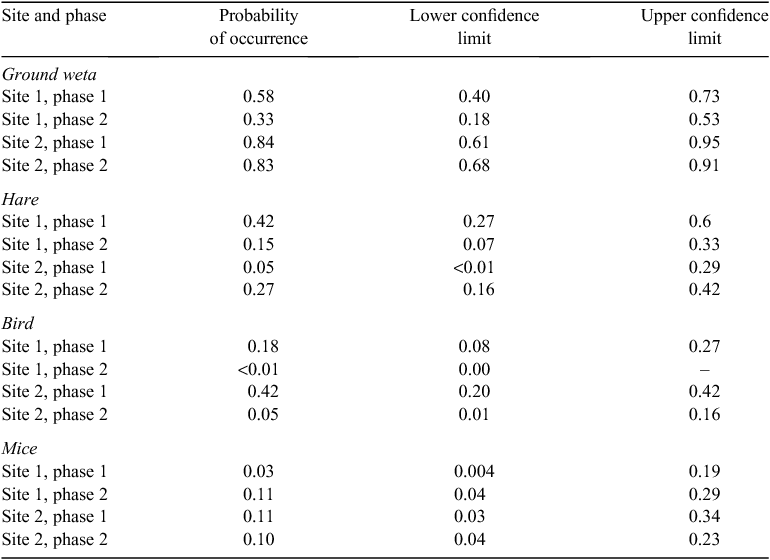Prey switching by stoats (Mustela erminea): a supplemental food experiment
Des H. V. Smith A E , Henrik Moller B , Deborah J. Wilson C and Elaine C. Murphy DA Centre for Conservation Research, Calgary Zoo, Calgary AB T2E 7V6, Canada.
B Department of Zoology, University of Otago, PO Box 56, Dunedin 9054, New Zealand.
C Landcare Research, Private Bag 1930, Dunedin 9054, New Zealand.
D Research, Development and Improvement Division, Department of Conservation, PO Box 13 049, Christchurch 8141, New Zealand.
E Corresponding author. Email: dess@calgaryzoo.ab.ca
Wildlife Research 37(7) 604-611 https://doi.org/10.1071/WR10088
Submitted: 26 May 2010 Accepted: 19 November 2010 Published: 17 December 2010
Abstract
Context
Prey switching by invasive carnivorans to changing food supply could severely impact on endemic prey of conservation importance, but experimental evidence for prey switching in carnivorans is rare. Stoats (Mustela erminea) were introduced to New Zealand and now threaten survival of many native birds, reptiles and invertebrates.
Aim
Our primary objective was to see whether abundant food caused stoats inhabiting an alpine grassland site to alter the rate at which they preyed upon weta (Orthoptera : Hemiandrus sp.), hares (Lepus europeus), birds and mice (Mus musculus).
Methods
We used dead rabbits as supplemental food in a before-after-control-impact experiment. Stoat scats were collected from a treatment and non-treatment site before and following food supplementation. Percentage frequency occurrence of the different prey types was assessed for the two sites during each experimental phase.
Conclusions
Stoats ate fewer ground weta and hares, the two most abundant prey types, when supplemental food was added. In contrast, consumption of mice remained relatively stable at both sites throughout the experiment, and the consumption of birds declined at both sites.
Implications
Our experiment suggests that stoats may continue to eat scarce endemic prey at similar per capita rates even when alternative prey are available. However, endemic prey that are locally or regionally abundant may be indirectly impacted by fluctuations in alternative prey.
Acknowledgements
We thank Georgina Pickerell, Peter Lei and Nicolas Couedel, who assisted in the field. Gary Tong, manager of the Borland Lodge, helped with accommodation and logistics. C. M. (Kim) King provided valuable comments on an earlier version of this paper. This research was funded by the Department of Conservation’s Stoat Technical Advisory Group (Research Contract: 3652) and the Zoology Department, University of Otago, and was approved by the University of Otago Animal Ethics Committee.
Akaike, H. (1974). A new look at statistical model identification. IEEE Transactions on Automatic Control AC 19, 716–723.
| Crossref | GoogleScholarGoogle Scholar |
Boutin, S. (1995). Testing predator-prey theory by studying fluctuating populations of small mammals. Wildlife Research 22, 89–100.
| Crossref | GoogleScholarGoogle Scholar |
Day, M. G. (1966). Identification of hair and feather remains in the gut and faeces of stoats and weasels. Journal of Zoology 148, 201–217.
| Crossref | GoogleScholarGoogle Scholar |
Holling, C. S. (1959). The components of predation as revealed by a study of small mammal predation of the European pine sawfly. Canadian Entomologist 91, 293–320.
| Crossref | GoogleScholarGoogle Scholar |
Letnic, M. , Koch, F. , Gordon, C. , Crowther, M. S. , and Dickman, C. R. (2009). Keystone effects of an alien top-predator stem extinctions of native mammals. Proceedings of the Royal Society B 276, 3249–3256.
| Crossref | GoogleScholarGoogle Scholar | PubMed |
McLennan, J. A. , Potter, M. , Robertson, H. A. , Wake, G. C. , Colbourne, R. , Dew, L. , Joyce, L. , McCann, A. J. , Miles, J. , and Miller, P. J. (1996). Role of predation in the decline of the kiwi, Apteryx spp., in New Zealand. New Zealand Journal of Ecology 20, 27–35.
Smith, D. H. V. , Jamieson, I. G. , and Peach, R. M. E. (2005). Importance of ground weta (Hemiandrus spp.) in stoat (Mustela erminea) diet in small montane valleys and alpine grasslands. New Zealand Journal of Ecology 29, 207–214.
Wilson, D. J. , and Lee, W. G. (2010). Primary and secondary resource pulses in an alpine ecosystem: snow tussock grass (Chionochloa spp.) flowering and house mouse (Mus musculus) populations in New Zealand. Wildlife Research 37, 89–103.
| Crossref | GoogleScholarGoogle Scholar |



